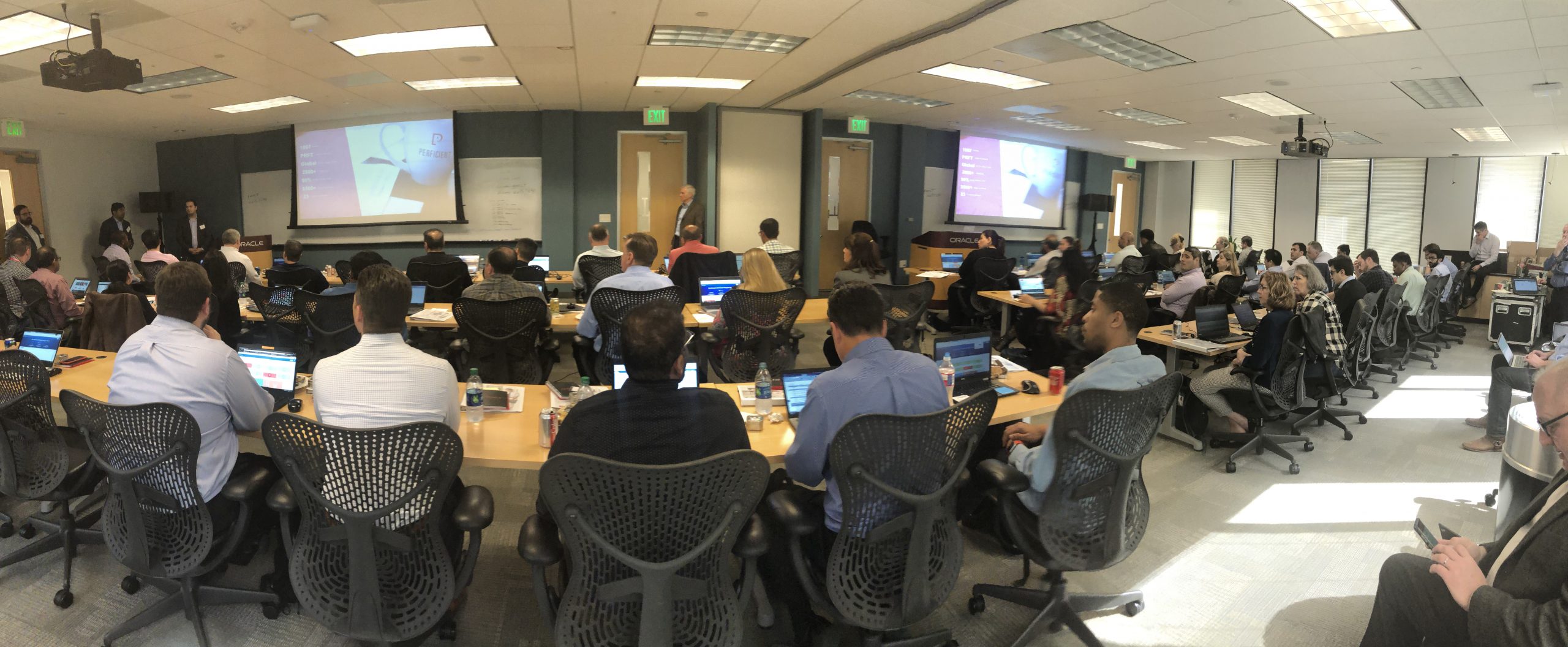Our team has been partnering with Oracle on running Oracle Analytics Cloud (OAC) Workshops all across North America. To date we have partnered in running more than 10 workshops, the most recent one was held yesterday in Houston, TX. We had a record number of attendees, more than double the capacity we had planned for. I would like to give a big shout out to both Perficient and Oracle Teams – Alliance, Marketing, and Sales Consultants in pulling off these very successful workshops. Also, a big thank you to our customers in carving out time to attend these four-hour sessions.
These workshops allow our customers, both business and IT, to test-drive the powerful capabilities of a next generation business analytics platform. From building cool visualizations to mashing-up data from multiple sources to using Machine Learning to cleanse and structure the data and building predictive models. We also explore building Essbase cubes via spreadsheets and using it as a source to mashup and build very interactive and dynamic visualizations. There are always ‘Aha’ and ‘Wow’ moments as the attendees explore new capabilities and functionalities of this powerful, cloud analytics platform.
In this post, I would like to reflect on my conversations with customers, commonly asked questions, and share feedback from our customers on the capabilities they think will have an immediate impact in their organization.
Oracle Analytics can do that?
Common across all the Workshops, I get the same feedback from business users who have long wanted the capability to perform self-service analysis, “I didn’t know that we could do this with Oracle Analytics!” Business users take what IT has created for them, structured data, and mashup with other sources like flat files to get the insights they need to make timely decisions. Exploring other technologies to meet user needs has led to some organizations owning multiple siloed Business Intelligence Platforms. The fact they can use OAC to not only access all the existing content they have in their production Oracle Business Intelligence (OBI) environment, but also empower business users by providing visualization capabilities is a key feature that most users believe they would like to roll-out to get immediate value within their organization.
How can you migrate from Oracle Business Intelligence to OAC?
The second most commonly asked question is, how can a customer with an existing OBI Platform migrate to OAC? This can be done in phases. Immediately rolling out Oracle Data Visualization is a quick win. Business users can start building ad-hoc capabilities. Next, the existing on-premises data warehouse can be accessed by OAC. At this stage, we would also migrate on-premises OBIEE metadata/dashboards/reports to OAC. Third, we would look to migrate the on-premises data warehouse and ETL process into cloud platforms. There are various approaches that customers have taken to migrate from on-premises OBI Platforms to OAC.
What about Machine Learning and OAC?
Machine Learning capabilities with OAC is one of the top three questions asked. In the workshop, users are able to take employee workforce profile data that has the history of their time period with the company and use the historical data to understand the correlation of attrition simply by asking OAC to explain ‘Attrition’. Additionally, we are able take the historical data to build predictive models and use the model to predict the typical attributes of employees who are likely to leave the organization. We discussed a number of use cases in the workshop around customer segmentation, predictive maintenance, and operational efficiency where this capability could be used to have an immediate impact in the organization.
Who is using OAC today?
Attendees are always interested in learning about customers who are using all of these capabilities. In the workshop, we discuss eight different case studies where customers have adopted Oracle Analytics Cloud to build a modern business analytics platform, this includes usage of Data Visualization success stories to building Enterprise Analytics on OAC. A number of success stories were discussed where customers are using OAC to integrate with Oracle Planning and Budgeting Cloud (PBCS), a data warehouse, and Enterprise Resource Planning (ERP) to get a single reporting platform for executive dashboard and mobile analytics. Users are able to come to a single reporting platform and get all the insights they need to make critical business decisions such as a consolidated view of Actuals, Budget and Forecast Data. They can drill down from a summary report to the detailed reports showing various ERP transactions.
Closing thoughts
Overall, I believe the OAC workshops are enabling our customers to see how they can leverage Oracle Data Visualization capabilities with numerous visualization tools (Heat map, donut, tag cloud, bar, circle pack, maps) to get insights by telling a powerful story. Mashup data from three different sources to get to the bottom of the issue all in a 20-minute exercise. Next, users get to test-drive data preparation and Machine Learning capabilities as a part of the Workshop Exercise using it to clean data, structure it, view a correlation and build predictive models. There is also an exercise where users take a spreadsheet to build an Essbase cube. Then students use this as one of the sources to build visually appealing and insightful visualizations. The feedback has been very positive and conversations are thought provoking.
We look forward to running more Oracle Analytics Cloud Hands-On Workshops in partnership with Oracle. if you have not attended one, I strongly recommend you to register for the next OAC workshop coming to your city. I look forward to having more thoughtful and engaging conversations with you.

